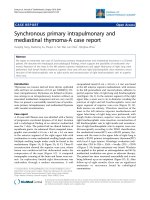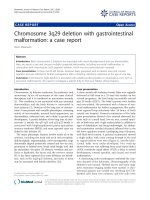Báo cáo y học: "The "incidental" episode of ventricular fibrillation: a case report." pdf
Bạn đang xem bản rút gọn của tài liệu. Xem và tải ngay bản đầy đủ của tài liệu tại đây (222.56 KB, 2 trang )
BioMed Central
Page 1 of 2
(page number not for citation purposes)
Journal of Medical Case Reports
Open Access
Case report
The "incidental" episode of ventricular fibrillation: a case report
Fahim H Jafary
Address: Department of Medicine, Section of Cardiology, Aga Khan University Hospital, Karachi, Pakistan
Email: Fahim H Jafary -
Abstract
Polymorphic ventricular tachycardia and ventricular fibrillation (VF) carry important prognostic
implications, especially in the post myocardial infarction period. However, artifact on the
electrocardiographic tracing can mimic VF particularly on routinely recorded rhythm strips in
hospitals. Such misinterpretation can lead to expensive (and potentially risky) diagnostic and
therapeutic steps. We report on such a case and highlight the need for careful inspection of the
tracing.
Background
Arrhythmias may be documented in patients with cardiac
or serious medical disorders admitted to units with telem-
etry monitoring, particularly intensive care wards [1]. Pol-
ymorphic ventricular tachycardia and ventricular
fibrillation (VF) carry particular prognostic signficance
owing to their association with sudden cardiac death.
However, artifact on the electrocardiographic tracing can
mimic VF particularly on routinely recorded rhythm strips
in hospitals. Misinterpretation can lead to expensive (and
potentially risky) diagnostic and therapeutic steps. We
report on such a case and highlight the need for careful
inspection of the tracing.
Case Presentation
This 45-year-old gentleman was admitted with an acute
inferoposterior myocardial infarction. Streptokinase was
administered with clinical and electrocardiographic evi-
dence of reperfusion. On the third day of admission, the
following rhythm strip (figure 1) was recorded on telem-
etry after the alarm went off. The patient was asympto-
matic and the event was documented as an episode of
"transient asymptomatic ventricular fibrillation". The
patient was presented on routine rounds the next morn-
ing.
Indeed, at first glance the rhythm strip appears to show
ventricular fibrillation, which carries significant prognos-
tic and therapeutic implications on the third post myocar-
dial infarction day. On closer review, QRS complexes can
be seen "marching through" the tracing (black dots), con-
firming that the apparent fibrillation is an artifact. Such
artifacts can be induced by movement, electrical interfer-
ence and lose monitor lead connections [2,3]. These elec-
trocardiographic artifacts are not uncommon and lead to
inappropriate diagnostic and therapeutic steps [4]
because they tend to be misinterpreted by physicians,
including cardiologists [5].
Conclusion
Given the widespread use of telemetry monitoring in
patients admitted on general medical and speciality serv-
ices, artifacts on rhythm tracings will inevitably occur. Cli-
nicians should keep such artifacts in mind when
interpreting rhythm tracings depicting ventricular fibrilla-
tion, particularly when other clinical correlates of this
lethal arrhythmia are absent. Careful inspection of the
tracing will usually clarify the diagnosis and prevent
expensive and potentially risky procedures that would
otherwise follow in a genuine case. Further study is war-
ranted to estimate the true prevalence of failure to appre-
Published: 30 August 2007
Journal of Medical Case Reports 2007, 1:72 doi:10.1186/1752-1947-1-72
Received: 13 December 2006
Accepted: 30 August 2007
This article is available from: />© 2007 Jafary; licensee BioMed Central Ltd.
This is an Open Access article distributed under the terms of the Creative Commons Attribution License ( />),
which permits unrestricted use, distribution, and reproduction in any medium, provided the original work is properly cited.
Publish with BioMed Central and every
scientist can read your work free of charge
"BioMed Central will be the most significant development for
disseminating the results of biomedical research in our lifetime."
Sir Paul Nurse, Cancer Research UK
Your research papers will be:
available free of charge to the entire biomedical community
peer reviewed and published immediately upon acceptance
cited in PubMed and archived on PubMed Central
yours — you keep the copyright
Submit your manuscript here:
/>BioMedcentral
Journal of Medical Case Reports 2007, 1:72 />Page 2 of 2
(page number not for citation purposes)
ciate this artifact amongst physicians of different
specialties and levels of experience.
List of Abbreviations
VF - Ventricular fibrillation.
Competing interests
The author(s) declare that they have no competing inter-
ests.
Authors' contributions
The author was responsible for the conception and writ-
ing of this manuscript.
Acknowledgements
Written consent was obtained from the patient for publication of this
report.
References
1. Tarditi DJ, Hollenberg SM: Cardiac arrhythmias in the intensive
care unit. Semin Respir Crit Care Med 2006, 27:221-229.
2. Srikureja W, Darbar D, Reeder GS: Tremor-induced ECG arti-
fact mimicking ventricular tachycardia. Circulation 2000,
102:1337-1338.
3. Vereckei A: Pseudo-ventricular tachycardia: electrocardio-
graphic artefact mimicking non-sustained polymorphic ven-
tricular tachycardia in a patient evaluated for syncope. Heart
2004, 90:81.
4. Knight BP, Pelosi F, Michaud GF, Strickberger SA, Morady F: Clinical
consequences of electrocardiographic artifact mimicking
ventricular tachycardia. N Engl J Med 1999, 341:1270-1274.
5. Knight BP, Pelosi F, Michaud GF, Strickberger SA, Morady F: Physi-
cian interpretation of electrocardiographic artifact that
mimics ventricular tachycardia. Am J Med 2001, 110:335-338.
"Ventricular fibrillation" – black dots mark QRS complexes "marching through" the artifact in the backgroundFigure 1
"Ventricular fibrillation" – black dots mark QRS complexes "marching through" the artifact in the background.









